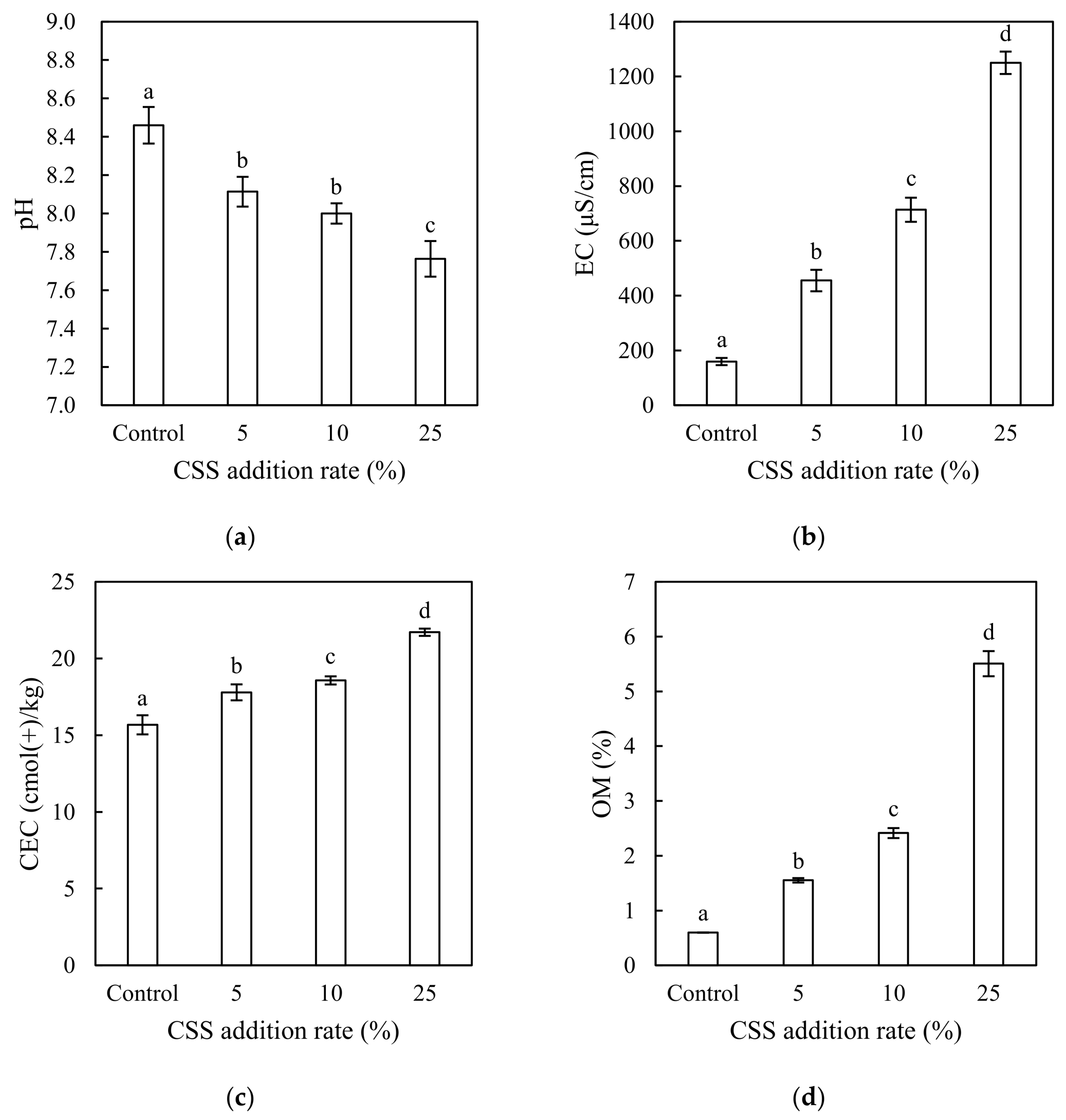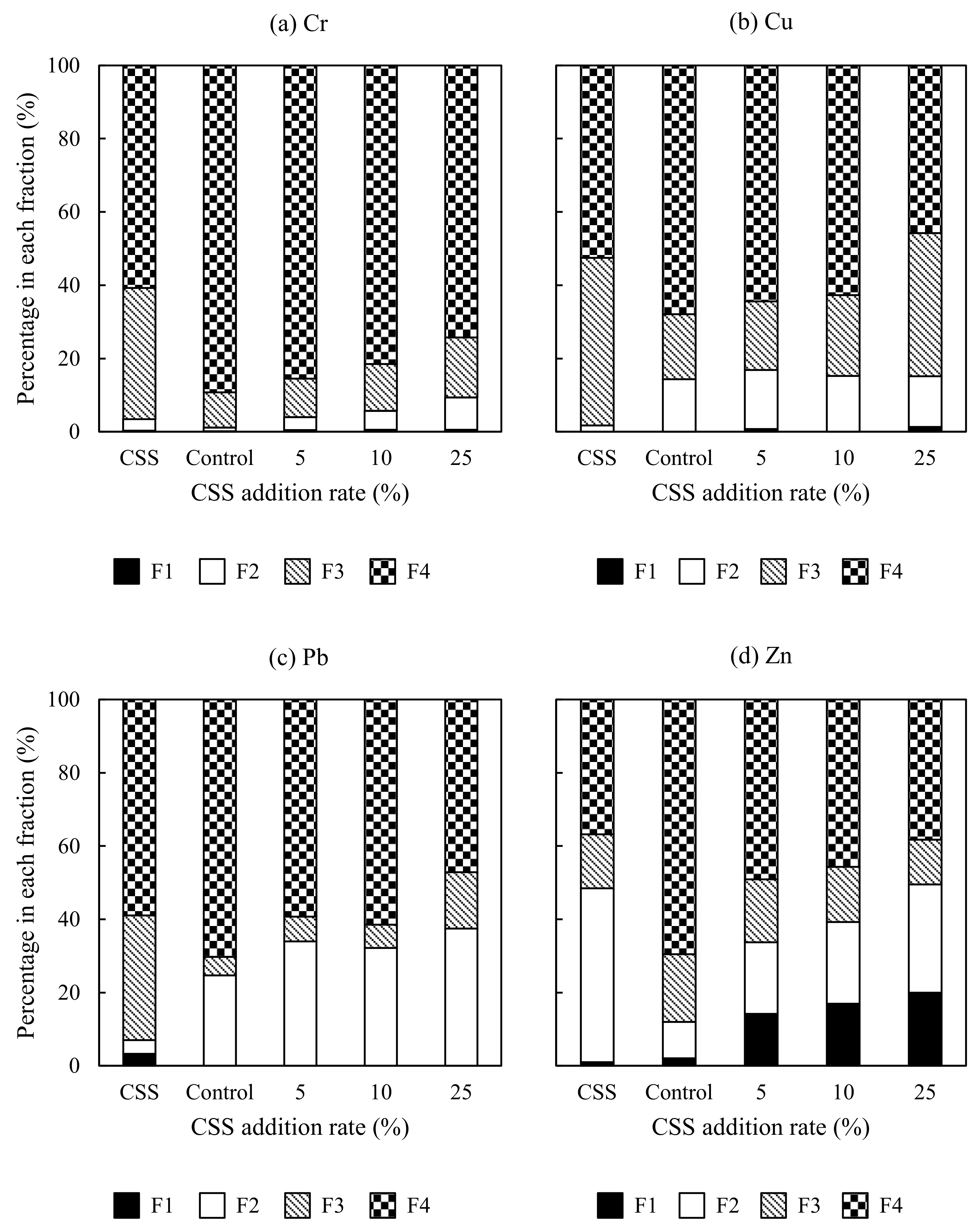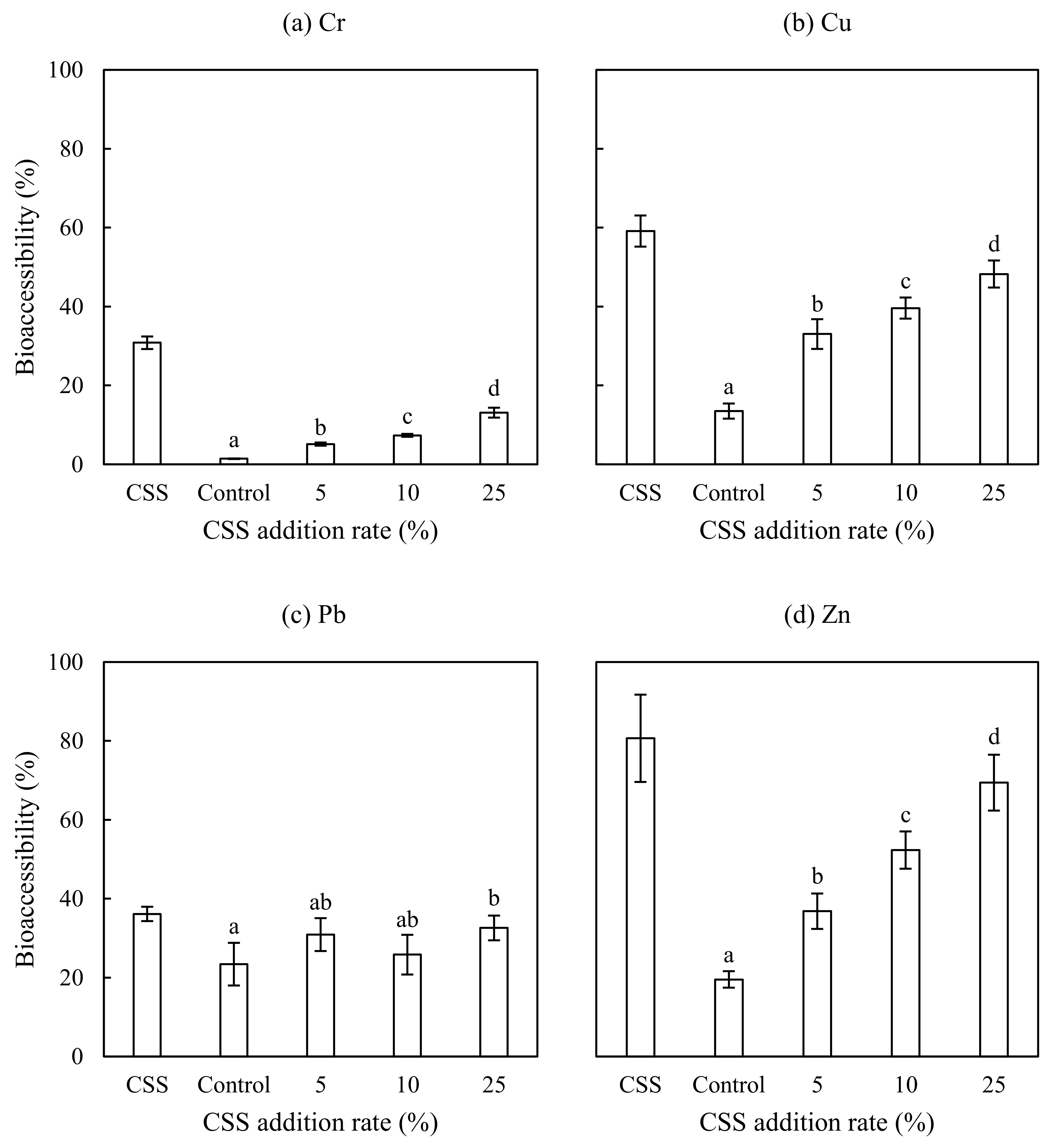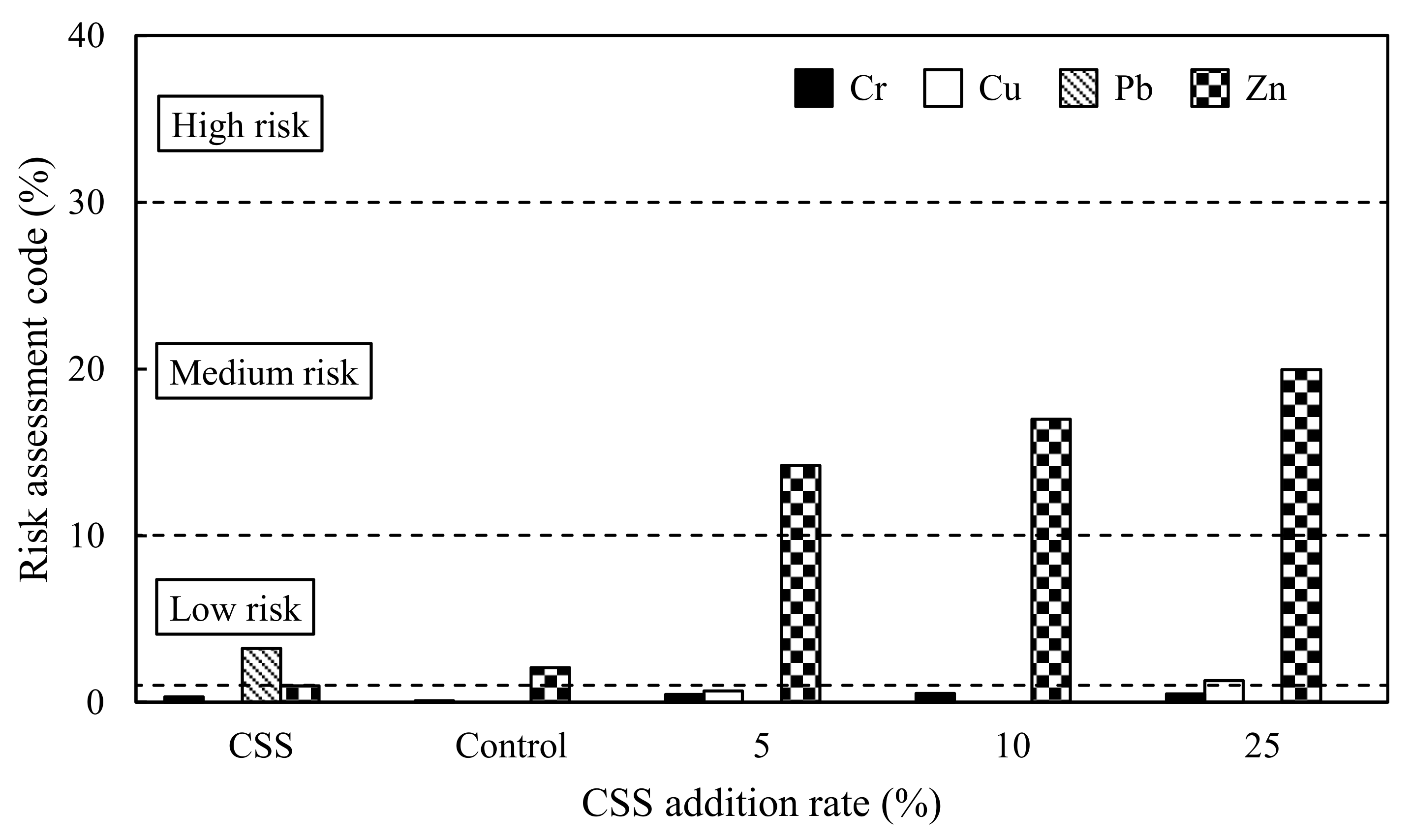Fractionation, Bioaccessibility, and Risk Assessment of Heavy Metals in the Soil of an Urban Recreational Area Amended with Composted Sewage Sludge
Abstract
:1. Introduction
2. Materials and Methods
2.1. Soil and CSS
2.2. Incubation Test
2.3. Physicochemical Analysis
2.4. Heavy Metal Analysis
2.5. Environmental and Health Risk Assessments
2.6. Data Analysis
3. Results and Discussion
3.1. Physicochemical Properties
3.2. Total Heavy Metal Concentrations
3.3. Fractionation and Bioaccessibility of Heavy Metals
3.4. Environmental and Health Risk Assessment
4. Conclusions
Acknowledgments
Author Contributions
Conflicts of Interest
References
- Torri, S.I.; Corrêa, R.S.; Renella, G. Biosolid application to agricultural land—A contribution to global phosphorus recycle: A review. Pedosphere 2017, 27, 1–16. [Google Scholar] [CrossRef]
- Rigby, H.; Clarke, B.O.; Pritchard, D.L.; Meehan, B.; Beshah, F.; Smith, S.R.; Porter, N.A. A critical review of nitrogen mineralization in biosolids-amended soil, the associated fertilizer value for crop production and potential for emissions to the environment. Sci. Total Environ. 2016, 541, 1310–1338. [Google Scholar] [CrossRef] [PubMed]
- Asian Development Bank. Promoting Beneficial Sewage Sludge Utilization in the People’s Republic of China. Available online: https://www.adb.org/publications/promoting-beneficial-sewage-sludge-utilization-peoples-republic-china (accessed on 1 October 2017).
- Australian & New Zealand Biosolids Partnership. Australian Biosolids Statistics—2017. Available online: https://www.biosolids.com.au/guidelines/australian-biosolids-statistics/ (accessed on 7 February 2018).
- Yang, G.; Zhang, G.; Wang, H. Current state of sludge production, management, treatment and disposal in China. Water Res. 2015, 78, 60–73. [Google Scholar] [CrossRef] [PubMed]
- Analysis of the Current Development Status of Sewage Sludge Treatment Industry and Prediction of the Future Development Prospect in China in 2017. Available online: http://www.chyxx.com/industry/201708/552343.html (accessed on 1 March 2018). (In Chinese).
- Yang, K.; Zhu, Y.; Shan, R.; Shao, Y.; Tian, C. Heavy metals in sludge during anaerobic sanitary landfill: Speciation transformation and phytotoxicity. J. Environ. Manag. 2017, 189, 58–66. [Google Scholar] [CrossRef] [PubMed]
- Mosquera-Losada, R.; Amador-García, A.; Muñóz-Ferreiro, N.; Santiago-Freijanes, J.J.; Ferreiro-Domínguez, N.; Romero-Franco, R.; Rigueiro-Rodríguez, A. Sustainable use of sewage sludge in acid soils within a circular economy perspective. Catena 2017, 149, 341–348. [Google Scholar] [CrossRef]
- Bai, Y.; Zang, C.; Gu, M.; Gu, C.; Shao, H.; Guan, Y.; Wang, X.; Zhou, X.; Shan, Y.; Feng, K. Sewage sludge as an initial fertility driver for rapid improvement of mudflat salt-soils. Sci. Total Environ. 2017, 578, 47–55. [Google Scholar] [CrossRef] [PubMed]
- Cheng, H.; Xu, W.; Liu, J.; Zhao, Q.; He, Y.; Chen, G. Application of composted sewage sludge (CSS) as a soil amendment for turfgrass growth. Ecol. Eng. 2007, 29, 96–104. [Google Scholar] [CrossRef]
- Chu, S.; Wu, D.; Liang, L.L.; Zhong, F.; Hu, Y.; Hu, X.; Lai, C.; Zeng, S. Municipal sewage sludge compost promotes Mangifera persiciforma tree growth with no risk of heavy metal contamination of soil. Sci. Rep. 2017, 7, 13408. [Google Scholar] [CrossRef] [PubMed]
- Soriano-Disla, J.M.; Gómez, I.; Navarro-Pedreño, J.; Jordán, M.M. The transfer of heavy metals to barley plants from soils amended with sewage sludge with different heavy metal burdens. J. Soils Sediments 2014, 14, 687–696. [Google Scholar] [CrossRef]
- Wu, L.; Yang, L.; Wang, Z.; Cheng, M.; Li, Z.; Liu, W.; Ma, T.; Christie, P.; Luo, Y. Uptake of silver by brown rice and wheat in soils repeatedly amended with biosolids. Sci. Total Environ. 2018, 612, 94–102. [Google Scholar] [CrossRef] [PubMed]
- Bai, Y.; Zuo, W.; Zhao, H.; Mei, L.; Gu, C.; Guan, Y.; Wang, X.; Gu, M.; Zang, C.; Shan, Y.; et al. Distribution of heavy metals in maize and mudflat saline soil amended by sewage sludge. J. Soils Sediments 2017, 17, 1565–1578. [Google Scholar] [CrossRef]
- Dœlsch, E.; Deroche, B.; de Kerchove, V.V. Impact of sewage sludge spreading on heavy metal speciation in tropical soils (Réunion, Indian Ocean). Chemosphere 2006, 65, 286–293. [Google Scholar] [CrossRef] [PubMed]
- Hamidpour, M.; Khadivi, E.; Afyuni, M. Residual effects of biosolids and farm manure on speciation and plant uptake of heavy metals in a calcareous soil. Environ. Earth Sci. 2016, 75, 1037. [Google Scholar] [CrossRef]
- Qiao, X.; Luo, Y.; Christie, P.; Wong, M. Chemical speciation and extractability of Zn, Cu and Cd in two contrasting biosolids-amended clay soils. Chemosphere 2003, 50, 823–829. [Google Scholar] [CrossRef]
- Shrivastava, S.K.; Banerjee, D.K. Speciation of metals in sewage sludge and sludge-amended soils. Water Air Soil Pollut. 2004, 152, 219–232. [Google Scholar] [CrossRef]
- Florido, M.C.; Madrid, F.; Madrid, L. Effect of an organic amendment on availability and bio-accessibility of some metals in soils of urban recreational areas. Environ. Pollut. 2011, 159, 383–390. [Google Scholar] [CrossRef] [PubMed]
- Tongesayi, T.; Dasilva, P.; Dilger, K.; Hollingsworth, T.; Mooney, M. Speciation and cysteine-simplified physiological-based extraction technique (SBET) bioaccesibility of heavy metals in biosolids. J. Environ. Sci. Health A 2011, 46, 1138–1146. [Google Scholar] [CrossRef] [PubMed]
- Environment Protection Authority Victoria. Guidelines for Environmental Management–Biosolids Land Application; Environment Protection Authority Victoria: Southbank, VIC, Australia, 2004. [Google Scholar]
- Bao, S. Soil Agricultural Chemical Analysis, 3rd ed.; China Agriculture Press: Beijing, China, 2013. (In Chinese) [Google Scholar]
- International Organization for Standardization. Particle Size Analysis—Laser Diffraction Methods (ISO 13320:2009); International Organization for Standardization: Geneva, Switzerland, 2009. [Google Scholar]
- Rauret, G.; Lopez-Sanchez, J.F.; Sahuquillo, A.; Barahona, E.; Lachica, M.; Ure, A.M.; Davidson, C.M.; Gomez, A.; Luck, D.; Bacon, J.; et al. Application of a modified BCR sequential extraction (three-step) procedure for the determination of extractable trace metal contents in a sewage sludge amended soil reference material (CRM 483), complemented by a three-year stability study of acetic acid and EDTA extractable metal content. J. Environ. Monit. 2000, 2, 228–233. [Google Scholar] [PubMed]
- Hu, X.; Zhang, Y.; Luo, J.; Wang, T.; Lian, H.; Ding, Z. Bioaccessibility and health risk of arsenic, mercury and other metals in urban street dusts from a mega-city, Nanjing, China. Environ. Pollut. 2011, 159, 1215–1221. [Google Scholar] [CrossRef] [PubMed]
- United States Environmental Protection Agency. Standard Operating Procedure for an In Vitro Bioaccessibility Assay for Lead in Soil (EPA 9200.2-86); United States Environmental Protection Agency: Washington, DC, USA, 2012. [Google Scholar]
- Perin, G.; Craboledda, L.; Lucchese, M.; Cirillo, R.; Dotta, L.; Zanetta, M.L.; Oro, A.A. Heavy metal speciation in the sediments of northern Adriatic Sea—A new approach for environmental toxicity determination. In Heavy Metals in the Environment; Lakkas, T.D., Ed.; CEP Consultants: Edinburg, UK, 1985; Volume 2. [Google Scholar]
- United States Environmental Protection Agency. Risk Assessment Guidance for Superfund: Volume III—Part A, Process for Conducting Probabilistic Risk Assessment (EPA 540-R-02-002); United States Environmental Protection Agency: Washington, DC, USA, 2001. [Google Scholar]
- Poggio, L.; Vrščaj, B.; Schulin, R.; Hepperle, E.; Marsan, F.A. Metals pollution and human bioaccessibility of topsoils in Grugliasco (Italy). Environ. Pollut. 2009, 157, 680–689. [Google Scholar] [CrossRef] [PubMed]
- Liu, J.; Zhang, X.; Tran, H.; Wang, D.; Zhu, Y. Heavy metal contamination and risk assessment in water, paddy soil, and rice around an electroplating plant. Environ. Sci. Pollut. Res. 2011, 18, 1623–1632. [Google Scholar] [CrossRef] [PubMed]
- International Society of Soil Science. Minutes of the first commission meetings, International Congress of Soil Science. Trans. First Comm. Int. Soc. Soil Sci. 1929, 4, 215–220. [Google Scholar]
- Han, B.; Liu, Y.; Zhao, F.; Liu, H. Characteristics and comprehensive assessment of the fertility of urban park soils in Jinan. Sci. Technol. Landsc. Archit. 2012, 123, 18–22. (In Chinese) [Google Scholar]
- General Administration of Quality Supervision, Inspection and Quarantine; The Standardization Administration. Disposal of Sludge from Municipal Wastewater Treatment Plant—Quality of Sludge Used in Gardens or Parks (GB/T 23486–2009); Standards Press of China: Beijing, China, 2009. (In Chinese)
- National Environmental Protection Agency. Environmental Quality Standard for Soils (GB 15618–1995); Standards Press of China: Beijing, China, 1995. (In Chinese) [Google Scholar]
- National Environment Protection Council. National Environment Protection (Assessment of Site Contamination) Measure 1999; National Environment Protection Council: Canberra, ACT, Australia, 2013. [Google Scholar]
- National Environmental Protection Agency; China National Environmental Monitoring Centre. Background Concentrations of Elements in Soils of China; China Environmental Science Press: Beijing, China, 1990. (In Chinese) [Google Scholar]
- Kabata-Pendias, A.; Pendias, H. Trace Elements in Soils and Plants, 3rd ed.; CRC Press: Boca Raton, FL, USA, 2001. [Google Scholar]
- Zhong, X.; Zhou, S.; Zhu, Q.; Zhao, Q. Fraction distribution and bioavailability of soil heavy metals in the Yangtze River Delta—A case study of Kunshan City in Jiangsu Province, China. J. Hazard. Mater. 2011, 198, 13–21. [Google Scholar] [CrossRef] [PubMed]
- Kim, K.R.; Owens, G.; Naidu, R. Heavy metal distribution, bioaccessibility, and phytoavailability in long-term contaminated soils from Lake Macquarie, Australia. Aust. J. Soil Res. 2009, 47, 166–176. [Google Scholar] [CrossRef]
- Luo, X.; Yu, S.; Li, X. The mobility, bioavailability, and human bioaccessibility of trace metals in urban soils of Hong Kong. Appl. Geochem. 2012, 27, 995–1004. [Google Scholar] [CrossRef]
- Yang, K.; Cattle, S.R. Bioaccessibility of Pb in urban soil of Broken Hill, Australia: A study based on in vitro digestion and the IEUBK model. Sci. Total Environ. 2015, 538, 922–933. [Google Scholar] [CrossRef] [PubMed]
- Liu, Y.; Bello, O.; Rahman, M.M.; Dong, Z.; Islam, S.; Naidu, R. Investigating the relationship between lead speciation and bioaccessibility of mining impacted soils and dusts. Environ. Sci. Pollut. Res. 2017, 24, 17056–17067. [Google Scholar] [CrossRef] [PubMed]
- Pascaud, G.; Leveque, T.; Soubrand, M.; Boussen, S.; Joussein, E.; Dumat, C. Environmental and health risk assessment of Pb, Zn, As and Sb in soccer field soils and sediments from mine tailings: Solid speciation and bioaccessibility. Environ. Sci. Pollut. Res. 2014, 21, 4254–4264. [Google Scholar] [CrossRef] [PubMed]
- Cai, M.; McBride, M.B.; Li, K. Bioaccessibility of Ba, Cu, Pb, and Zn in urban garden and orchard soils. Environ. Pollut. 2016, 208, 145–152. [Google Scholar] [CrossRef] [PubMed]
- Cui, Y.; Chen, X. Lead (Pb) and arsenic (As) bioaccessibility in various soils from south China. Environ. Monit. Assess. 2011, 177, 481–492. [Google Scholar] [CrossRef] [PubMed]
- Walraven, N.; Bakker, M.; van Os, B.J.H.; Klaver, G.T.; Middelburg, J.J.; Davies, G.R. Factors controlling the oral bioaccessibility of anthropogenic Pb in polluted soils. Sci. Total Environ. 2015, 506–507, 149–163. [Google Scholar] [CrossRef] [PubMed]
- Patinha, C.; Reis, A.P.; Dias, C.; Cachada, A.; Adão, R.; Martins, H.; da Silva, E.F.; Sousa, A.J. Lead availability in soils from Portugal’s Centre Region with special reference to bioaccessibility. Environ. Geochem. Health 2012, 34, 213–227. [Google Scholar] [CrossRef] [PubMed]




| Item | Garden Soil a | CSS a | Urban Park Soils in Jinan b |
|---|---|---|---|
| pH1:5 solid/water | 8.46 ± 0.05 | 7.58 ± 0.02 | 8.26 ± 0.19 |
| EC1:5 solid/water (μS/cm) | 142 ± 18 | 5013 ± 103 | - |
| CEC (cmol(+)/kg) | 15.3 ± 0.6 | 45.4 ± 0.8 | - |
| OM (%) | 0.64 ± 0.00 | 25.63 ± 0.53 | 1.49 ± 0.91 |
| TN (%) | 0.04 ± 0.00 | 1.20 ± 0.03 | 0.09 ± 0.04 |
| Clay (0.01–2 μm v/v %) | 12.2 ± 0.4 | 6.0 ± 0.3 | - |
| Silt (2–20 μm v/v %) | 34.7 ± 0.3 | 32.5 ± 1.6 | - |
| Sand (20–2000 μm v/v %) | 53.1 ± 0.6 | 61.5 ± 1.9 | - |
| CSS Addition Rate (%) | Cr (mg/kg) | Cu (mg/kg) | Pb (mg/kg) | Zn (mg/kg) |
|---|---|---|---|---|
| Control | 70.5 ± 5.0 a | 24.0 ± 2.8 a | 28.7 ± 2.4 a | 73.5 ± 5.0 a |
| 5 | 78.0 ± 6.0 ab | 36.3 ± 1.2 b | 30.1 ± 1.2 a | 91.0 ± 10.4 ab |
| 10 | 81.7 ± 4.0 bc | 48.0 ± 2.7 c | 36.6 ± 7.3 ab | 106.7 ± 8.0 b |
| 25 | 89.0 ± 3.6 c | 79.7 ± 9.0 d | 39.2 ± 5.3 b | 149.7 ± 7.5 c |
| Element | Ceiling Concentrations (mg/kg) | Soil Background Values in Shandong Province (mg/kg) d | |||||
|---|---|---|---|---|---|---|---|
| Sludge Quality Standard | Soil Quality Standard | ||||||
| China a | China b | Australia c | |||||
| Soil pH ≥ 6.5 | Grade A | Grade B (pH > 7.5) | Grade C | HIL A | HIL C | ||
| Cr | 1000 | 90 | 250 | 300 | 100 | 300 | 64.3 |
| Cu | 1500 | 35 | 100 | 400 | 6000 | 17,000 | 22.3 |
| Pb | 1000 | 35 | 350 | 500 | 300 | 600 | 24.5 |
| Zn | 4000 | 100 | 300 | 500 | 7400 | 30,000 | 60.9 |
| MetalBioaccessibility | MetalTotal | MetalResidual | pH | EC | CEC | OM |
|---|---|---|---|---|---|---|
| CrBioaccessibility | 0.840 ** | −0.985 ** | −0.956 ** | 0.989 ** | 0.976 ** | 0.965 ** |
| CuBioaccessibility | 0.842 ** | −0.788 ** | −0.957 ** | 0.919 ** | 0.905 ** | 0.849 ** |
| PbBioaccessibility | −0.025 | −0.646 * | −0.532 | 0.512 | 0.494 | 0.520 |
| ZnBioaccessibility | 0.905 ** | −0.919 ** | −0.957 ** | 0.977 ** | 0.926 ** | 0.910 ** |
| CSS Addition Rate (%) | Receptor | Cr | Cu | Pb | Zn | HI | |
|---|---|---|---|---|---|---|---|
| HQ | Carcinogenic Risk | HQ | HQ | HQ | |||
| Control | Children | 2.16 × 10−3 | 2.78 × 10−7 | 5.33 × 10−4 | 1.26 × 10−2 | 3.14 × 10−4 | 1.56 × 10−2 |
| Adults | 2.32 × 10−4 | 1.19 × 10−7 | 5.71 × 10−5 | 1.35 × 10−3 | 3.37 × 10−5 | 1.67 × 10−3 | |
| 5 | Children | 8.72 × 10−3 | 1.12 × 10−6 | 1.97 × 10−3 | 1.75 × 10−2 | 7.34 × 10−4 | 2.89 × 10−2 |
| Adults | 9.34 × 10−4 | 4.80 × 10−7 | 2.11 × 10−4 | 1.87 × 10−3 | 7.86 × 10−5 | 3.10 × 10−3 | |
| 10 | Children | 1.33 × 10−2 | 1.70 × 10−6 | 3.12 × 10−3 | 1.77 × 10−2 | 1.22 × 10−3 | 3.53 × 10−2 |
| Adults | 1.42 × 10−3 | 7.30 × 10−7 | 3.35 × 10−4 | 1.90 × 10−3 | 1.31 × 10−4 | 3.79 × 10−3 | |
| 25 | Children | 2.56 × 10−2 | 3.29 × 10−6 | 6.33 × 10−3 | 2.40 × 10−2 | 2.28 × 10−3 | 5.82 × 10−2 |
| Adults | 2.74 × 10−3 | 1.41 × 10−6 | 6.78 × 10−4 | 2.57 × 10−3 | 2.44 × 10−4 | 6.23 × 10−3 | |
© 2018 by the authors. Licensee MDPI, Basel, Switzerland. This article is an open access article distributed under the terms and conditions of the Creative Commons Attribution (CC BY) license (http://creativecommons.org/licenses/by/4.0/).
Share and Cite
Yang, K.; Zhang, T.; Shao, Y.; Tian, C.; Cattle, S.R.; Zhu, Y.; Song, J. Fractionation, Bioaccessibility, and Risk Assessment of Heavy Metals in the Soil of an Urban Recreational Area Amended with Composted Sewage Sludge. Int. J. Environ. Res. Public Health 2018, 15, 613. https://doi.org/10.3390/ijerph15040613
Yang K, Zhang T, Shao Y, Tian C, Cattle SR, Zhu Y, Song J. Fractionation, Bioaccessibility, and Risk Assessment of Heavy Metals in the Soil of an Urban Recreational Area Amended with Composted Sewage Sludge. International Journal of Environmental Research and Public Health. 2018; 15(4):613. https://doi.org/10.3390/ijerph15040613
Chicago/Turabian StyleYang, Kai, Tao Zhang, Yanqiu Shao, Chao Tian, Stephen R. Cattle, Ying Zhu, and Jinjuan Song. 2018. "Fractionation, Bioaccessibility, and Risk Assessment of Heavy Metals in the Soil of an Urban Recreational Area Amended with Composted Sewage Sludge" International Journal of Environmental Research and Public Health 15, no. 4: 613. https://doi.org/10.3390/ijerph15040613





